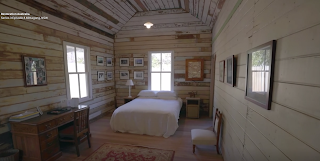Heritage devotees Val and John Jessop decide to buy and reassemble two old buildings - an old ghost town cottage and an old sawmill. What could be more difficult than that? (Season Final)
So we get to the final episode of series 3. John is from England via Africa and Val a Mittagong local with connections to the shale oil mining town of Joadja. They have already done a big renovation / extension, of an old school and church elsewhere. Now they plan another passion project to recreate a cute cottage with a fancy modern bit out the back.
Their business, Cotswold Furniture Collection, isn't mentioned in the show but the end result of their involvement with the show looks like the sort of interior decorating magazine shoot that would be perfect advertising.
Their plan is to reassemble a house and sawmill shed from "flat pack" components. The house was moved from Joadja to Mittagong and at some stage was dismantled and the parts stacked in Willie Hall's salvage yard.
Willie is the secret weapon in their quest for a unique house - a particularly attuned builder, preserver of old stuff, and son of Peter Hall, the architect who rescued the Opera House. Hall is calm, quietly spoken and competent in all sorts of skills. He is the perfect foil to the fake drama of reality TV. He is actually real.
The sawmill was that of Alex S Blatch & Sons. It was still operating until 1998 when it had to close, supposedly because of the NSW ban on old growth logging according to one of the sons Graeme (SMH June 17, 1998). The Blatch family had offers for their "home-cut, wooden office, and corrugated iron shed from a local artist and a potter who liked the old, lived-in look,"
The sawmill was a landmark in Mittagong, and one of the last connections to the timber industry, that had for a century been the mainstay of the Southern Highlands.
But in the end it was cleared away for some drab townhouses.
Hall has a thorough grasp of good heritage conservation practice. He bought the house and dismantled it, presumably as a last option to prevent its loss. He took photos of the dismantling process and tagged the parts. He uses traditional construction methods and where parts needed to be replaced because of rot or termites, he used matching materials. He even has an old
morticing machine to do the new mortice and tenon joints. This seems like a rare lost trade, but in fact is a simple piece of equipment to acquire and use today - its just that modern nail guns serve the same purpose with minimum effort.
So if a building has been moved from its original historic town and had a second life in another historic town, then dismantled and stored in for years before being moved again to a third site and reconstructed with building where it is married to modern materials, is it still heritage?
I suspect not, but Harrison goes on again about heritage practice needing to identify new building by cladding it in new material. But in this case it doesn't seem such an issue since so little of the build is actually original fabric or in its original configuration, while significant visual elements such as the cladding of both the sawmill shed and the house roof are done in new Zincalume removing any sense of heritage character. If there was no option but use new material, they still could have obtained proper
galvanised corrugated iron for much the same price. At least then they could have some reference to
Australian building heritage.
They have left some of the original internal wall finishes as a palimpsest of the layers of use and reconstruction, although the appearance is more of a contrived shabby chic, with mismatched boards, gaps and missing trim all over the place. It seems much was left behind when the house was dismantled.
With such a calm and competent builder, clients with patience and evidently adequate financial means and no council regulator or heritage advisor hovering over the building site threatening to close it all down if they don't use the right shade of Porters lime wash, there is little opportunity in the show for the usual fabricated drama. So instead it comes from the bushfires and the epidemic.
As with the previous episode the virus keeps Harrison away but it is no loss as Willie makes a more authentic and personable narrator. What you aren't told however, is how this project is really just a bit of ordinary property development. The house/shed combo is squashed into a subdivided block next door to the Jessop's real house - a large and more prosaic late 20th century ranch style home on half a hectare. The original house on the block on the other side is now tight up against the fence, and the garden trees are all gone, making Mittagong a little less leafy.
The result is far more a pastiche of what passes for heritage on television, than actual restoration, but after the abominations on most of the renovation shows we don't really expect much more than this.














No comments:
Post a Comment